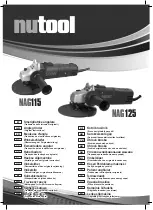
2
SAFETY INSTRUCTIONS
To reduce risk of injury, everyone using, installing, repairing,
maintaining, changing accessories on, or working near this tool must
read and understand these instructions before performing any such
task.
DO NOT DISCARD - GIVE TO USER
The goal of Chicago Pneumatic is to produce tools that help
you work safely and efficiently. The most important safety
device for this or any tool is YOU. Your care and good
judgment are the best protection against injury. All possible
hazards cannot be covered here, but we have tried to
highlight some of the important ones.
For Additional Safety Information Consult:
!
Your employer, union and/or trade association.
!
US Department of Labor (OSHA); www.osha.gov;
Council of the European Communities
europe.osha.eu.int
!
“Safety Requirements for the Use, Care and Protection
of Abrasive Wheels” (ANSI B7.1) and “Safety Code for
Portable Air Tools” (ANSI B186.1) available from:
www.ansi.org
!
“Safety Requirements for Hand-Held Non-Electric Power
Tools” available from: European Committee for
Standardization, www.cenorm.be
Air Supply And Connection Hazards
!
Air under pressure can cause severe injury.
!
Always shut off air supply, drain hose of air pressure
and disconnect tool from air supply when not in use,
before changing accessories or when making repairs.
!
Never direct air at yourself or anyone else.
!
Whipping hoses can cause serious injury. Always check
for damaged or loose hoses and fittings.
!
Do not use quick disconnect couplings at tool. See
instructions for correct setup.
!
Whenever universal twist couplings are used, lock pins
must be installed.
!
Do not exceed maximum air pressure of 90 psi/6.2 bar
or as stated on tool nameplate.
Wheel Guard Usage
!
Always use the recommended wheel guard to prevent
injury from broken grinding wheel parts.
!
If a guard has withstood a wheel breakage do not
continue to use it. It may be damaged.
!
Position the guard between the grinding wheel and the
operator.
!
Use barriers to protect others from wheel fragments and
grinding sparks.
Projectile Hazards
!
Always wear impact-resistant eye and face protection
when involved with or near the operation, repair or
maintenance of the tool or changing accessories on the
tool.
!
Be sure all others in the area are wearing impact-
resistant eye and face protection.
!
Even small projectiles can injure eyes and cause
blindness.
!
A grinding wheel that bursts can cause very serious
injury.
!
Daily measure the air grinder speed with a tachometer
to make sure it is not greater than the RPM marked on
the grinding wheel.
!
Never use a grinding wheel marked with a speed lower
than the air grinder speed.
Grinding Wheel Mounting Hazards
!
Correct grinding wheel mounting is necessary to
prevent injury from broken wheels.
!
Do not use chipped or cracked grinding wheels.
!
Grinding wheels should be a free fit on the spindle to
prevent stress at the hole.
!
Use only wheel collars that come with the grinder for
mounting the grinding wheel.
!
Flat washers or other adapters may over stress the
wheel. Always use heavy paper blotter discs between
the wheel collars and the grinding wheel.
!
Tighten the wheel on the spindle to prevent spin off
when the air grinder is turned off.
!
Before grinding, test grinding wheel by briefly running
tool at full throttle. Be sure to use a barrier (such as
under a heavy work table) to stop any possible broken
wheel parts.
Workplace Hazards
!
Slip/Trip/Fall is a major cause of serious injury or death.
Be aware of excess hose left on the walking or work
surface.
!
High sound levels can cause permanent hearing loss.
Use hearing protection as recommended by your
employer or OSHA regulation (see 29 CFR part 1910).
!
Maintain a balanced body position and secure footing.
!
Repetitive work motions, awkward positions and
exposure to vibration can be harmful to hands and
arms. If numbness, tingling, pain or whitening of the
skin occurs, stop using tool and consult a physician.
!
Avoid inhaling dust or handling debris from the work
process which can be harmful to your health. Use dust
extraction and wear respiratory protective equipment
when working with materials which produce airborne
particles.
!
Operators and maintenance personnel must be
physically able to handle the bulk, weight and power of
this tool.
!
This tool is not intended for use in explosive
atmospheres and is not insulated for contact with
electric power sources.
!
Some dust created by power sanding, sawing, grinding,
drilling and other construction activities contains
chemicals known to the State of California to cause
cancer and birth defects or other reproductive harm.
Some examples of these chemicals are:
- Lead from lead based paints
- Crystalline silica bricks and cement and other
masonry products
- And Arsenic and chromium from chemically-
treated rubber
Your risk from these exposures varies, depending on
how often you do this type of work. To reduce your
exposure to these chemicals: work in a well ventilated
area, and work with approved safety equipment, such as
dust masks that are specially designed to filter out
microscopic particles.
!
For professional use only.
Summary of Contents for RP9118
Page 32: ...NOTES ...
Page 33: ......






































